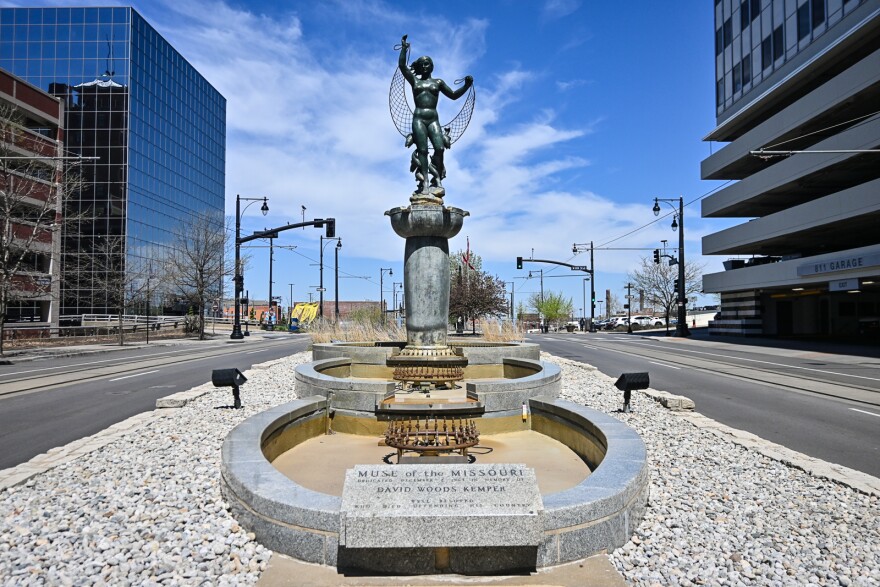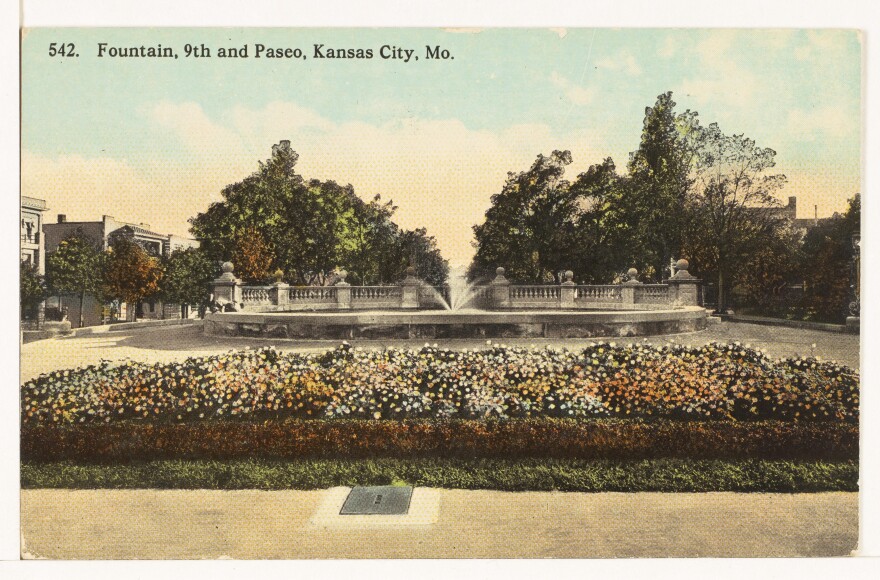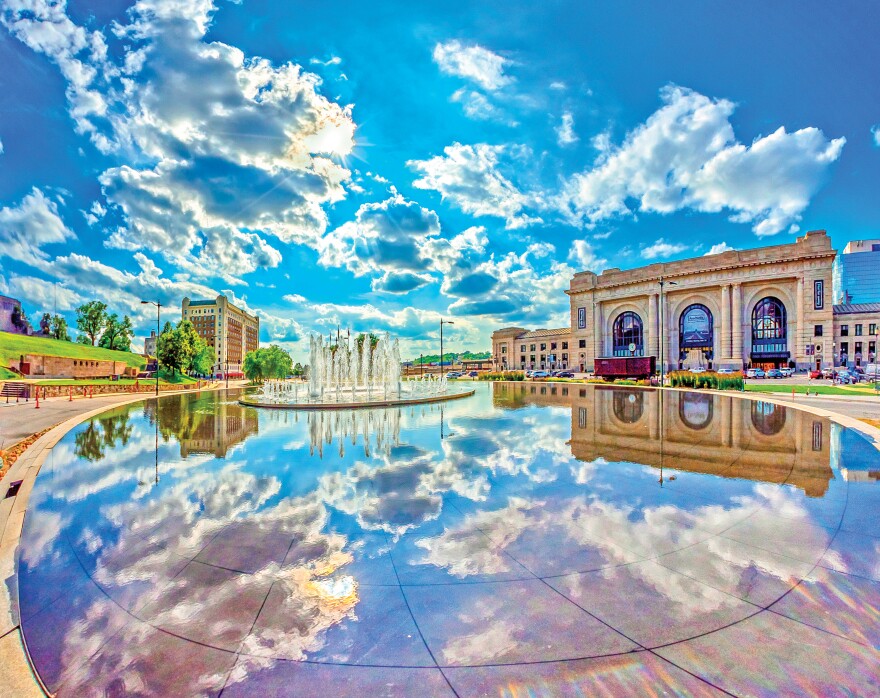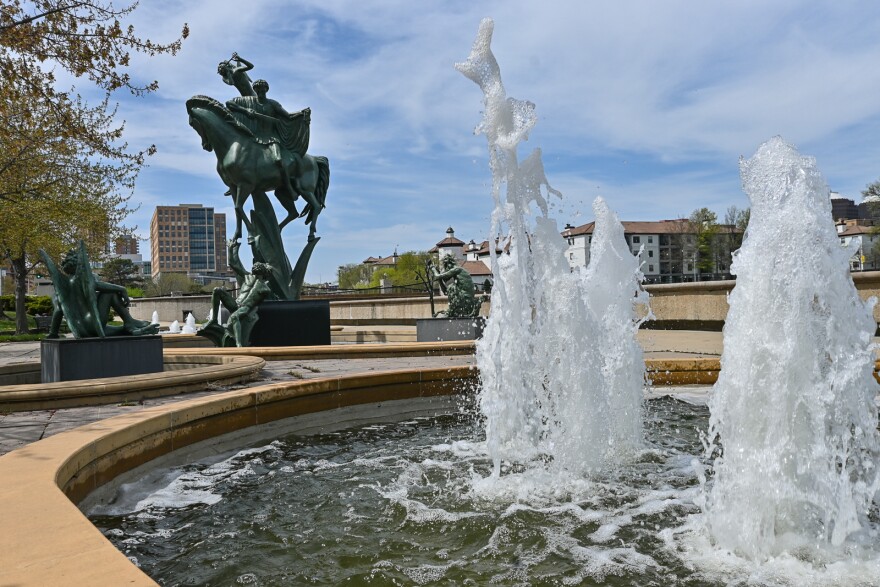This story was first published in KCUR's Adventure! newsletter. You can sign up to receive stories like this in your inbox every Tuesday.
Fountains are a key part of Kansas City’s culture: as landmarks, resting places, backdrops for special memories, and links to the Kansas City of the past.
Kansas City has been known as the City of Fountains since around the 1950s, but it became an official part of the city seal in 1992.
Patrice Eilts-Jobe designed that seal, combining the heart icon and fountain image, and it’s been flying on our flag since 2008. You can also find the seal on manhole covers and even some city-owned vehicles.
There are over 200 fountains in the greater Kansas City area, spanning classical to modern, realistic to whimsical. Whether centerpieces for public squares, tucked into nooks, or installed along main thoroughfares, these fountains beautify the area and honor many of the makers of yesteryear, like philanthropist William Volker and activist Bernard Powell.

Surrounding communities also boast fountains that speak to their particular histories and incorporate eye-catching sculptures, like the “Motherhood” bear fountain in Merriam, Kansas.
Only Rome has more fountains. In fact, a visit to Rome by Kansas Citians Harold and Peggy Rice inspired them to form the City of Fountains Foundation, a nonprofit organization created in 1973 — 50 years ago this year! — to support and maintain these important civic features.
Every April, the city celebrates Greater Kansas City Fountain Day, when 48 publicly owned fountains are officially switched on for the season.
This year, that happens on Wednesday, April 23. That day, there is a ceremony at the Fountain at Mill Creek Park at 2:30 p.m.
You can find a full list of the publicly owned fountains at kcparks.org or see most of the registered fountains in the area at CityOfFountains.org.
Let’s take a tour of some of Kansas City’s iconic fountains.
Our oldest fountains

The first public fountains in Kansas City were installed for the purpose of public hygiene, providing clean (or at least cleaner) drinking water for humans, horses and dogs.
A few of these remain, including the Intercity Horse Trough Fountain, which was moved from its 1904 location in downtown Kansas City, Kansas, to the Wyandotte County Museum in 1967.
It features lion faces for the spouts and you will notice that feature on a few other fountains around town, such as Meyer Circle Sea Horse Fountain and the Observation Park fountain. The lion is a symbol carried over from ancient Greece and still used frequently in fountain designs.
In 1899, the first fountain for beautification was installed at 15th and Paseo (though it has since been destroyed). Later that year, a second fountain was built at 9th and Paseo.

Now known as the Women’s Leadership Fountain, it is the city’s oldest-operational fountain and honors nine leaders in the community from the era, including architect Nelle Peters and dress maker and business owner Ellen (Nell) Donnelly Reed.
The oldest fountain in the city, though, is the Nelson-Atkins Museum of Art’s Fountain Basin, which is installed in Rozelle Court, a Roman “breciated marble bowl” from 220 C.E. Visitors throw wishing coins into the surrounding pool, which are collected and donated back to the museum.
City of Fountains Foundation

The City of Fountains Foundation helps maintain the city’s fountains, establishing endowments and raising funds for repairs. This year, the organization celebrates its 50th anniversary and there are a few different ways to join in the fun.
This season, the Foundation and KC Parks partnered with the Kansas City Royals, so Sluggerrr will be at the opening event on April 14. Throughout the season, significant fountains will run royal blue in honor of the team (see the full schedule here).
Dyeing fountains is a Kansas City tradition, bringing attention to different causes and events around town. There’s a whole lot of protocol around what type of dye and how the process works, which you can learn about on KC Park’s website.

Installed in 1910, the Fountain at Mill Creek Park (formerly J.C. Nichols Fountain) is the site of the festivities and is one of the city’s most photographed places, with rearing horses that represent four of the world’s mightiest rivers (according to KC Parks: the Mississippi — that’s the one with the alligator — the Volga, the Seine, and the Rhine), frolicking children, and spouting fish.
Just across the street is the Seville Light Fountain. It is an exact replica of Plaza de Los Reyes Fountain in sister city Seville, Spain. This fountain was installed in 1967, and its grotesque faces make for entertaining selfie spots if you’re exploring the Country Club Plaza.
In honor of Royals’ Opening Day and in support of City of Fountains Foundations, KC Bier Station launched its Fountain City Wheat. A portion of the proceeds goes to the foundation to help maintain and restore fountains.
Photographer Roy Inman’s popular 2012 book “The City of Fountains: Kansas City’s Legacy of Beauty and Motion” is getting a second version this year, available soon, with proceeds benefiting the City of Fountains Foundation.
Another fun initiative is the City of Fountains Foundation coloring book, available mid-April at Made in Kansas City stores and other local gift shops. It features drawings by Kansas City artists.
Icons of Kansas City

Fountains are at nearly every major landmark, like Union Station, Liberty Memorial, Nelson-Atkins Museum of Art, Crown Center, and Kauffman Stadium. At City Hall, you can see the Sea Horse Fountains, which have flanked the south entrance since 1938.
In front of Union Station, the Henry Wollman Bloch Fountain combines reflecting pool and water choreography. There are 232 jets that “perform” a five-minute show every 90 minutes, surrounded by a tier of flat black granite.
A water nymph (just one of the many mythological figures and fantastical creatures featured throughout Kansas City) is the “Muse of the Missouri” at the David Woods Kemper Memorial Fountain at 8th and Main Street.
At Kauffman Stadium, fountains spray and surge excitedly to the side of the scoreboard. There’s also a baseball-themed fountain in the kid-friendly Outfield Experience, the 5,000 pound marble sphere balanced on the gushing water.

Many businesses, communities, and private homes maintain fountains as well. Some operate year round, like many in the Country Club Plaza.
Around the city, designs can be inspired by classic Greek and Roman sculpture (like Neptune in the Plaza), reflect Hispanic heritage (like this one in the Westside), showcase modern elements (like the austere Vietnam Veterans' Memorial Fountain), or capture sweet scenes.
Some are relatively small, with only one spout, while others take up an entire block.
Sources of solace

Fountains adorn parks and gardens, all sparkly and burbling, stimulating and relaxing at the same time. They are a source of solace, as many of the region’s fountains were donated as memorials, making them points of reflection, too.
In the Ewing and Muriel Kauffman Memorial Garden, bronze statues of skipping girls are surrounded by manicured beds of flowers.
In the Laura Conyers Smith Municipal Rose Garden in Loose Park, the central basin fountain is the fourth iteration in that space, now a Romanesque style that suits the curved paths of the garden, making a picturesque picnic spot.
Nothing matches beauty and power quite like a waterfall, and Kansas City has its share. The Hillside Fountain cascades toward Brush Creek on the north side of the Bruce R. Watkins Cultural Center. It makes an impressive backdrop to the Brush Creek Amphitheater at Cleveland Ave and Emanuel Cleaver II Boulevard.
There, visitors can also view the emblematic Spirit of Freedom Fountain, with its flame-like sculpture designed by Richard Hunt, inspired by the contributions of Black Kansas Citians and the city’s jazz heritage. Further west, waterfalls frame the Theis Park Amphitheater, too.
Along Cliff Drive is the Carl DiCapo Fountain, a waterfall of rustic rock. Originally sourced by a natural spring, it’s a popular stop on the State Scenic Byway in George E. Kessler Park in the Historic Northeast neighborhood.
Get up close

These are only a portion of the city’s fountains. To learn more, consider taking a tour, whether walking, driving, virtual, or self-determined, or just pause the daily grind to appreciate what’s nearby. You’ll find clusters of fountains in some areas, like the Plaza or Downtown, while others stand proudly on their own.
Visit KC created a video of well known landmarks, accompanied by a string quartet from the Kansas City Symphony. KC Fountain Tours provides walking tours of the Country Club Plaza for a fee, visiting most of that area’s 17 fountains. The Clio, a history tour website, provides a step-by-step driving tour route of 49 of the city’s fountains.
City of Fountains Foundation offers lists of fountains by region, so you can see what’s around when traveling around town. They also provide a Google map, which marks the locations of all the registered fountains in the city.

While exploring, learn what distinguishes these impressive features and sprinkle your knowledge on friends, family, and out-of-town visitors. Or join the Fountains of Kansas City Facebook group.
Here are a few starting places for your own scavenger hunt: Where is the angel wearing a wristwatch? How many Kugel (German for ball or sphere) fountains are in the region? What’s a hippocampus? Can you find the “Fountain of Ewes” on Main Street?







